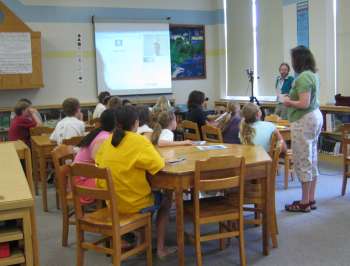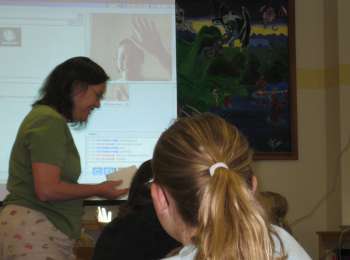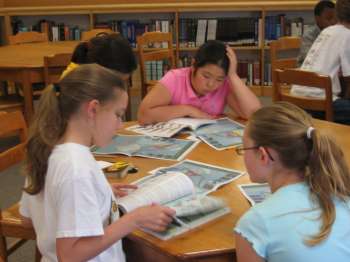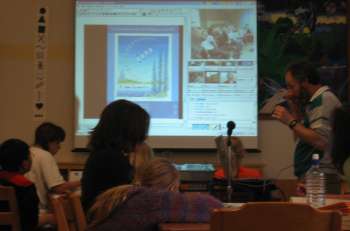- By Dan Veaner
- Around Town
 Print
Print
On Thursday, May 25 children from Ecuador, Mexico, Canada and the United States took a field trip to study birds all at the same time. Fifth Grade science teacher Therese Arsenault took her Lansing class along to study how birds migrate north to the Boreal Forest in Canada. The students trekked across the hemisphere sitting down, connected by computer to other classrooms and Yanayacu in eastern Ecuador Rancho La Liebre in Sinaloa, Mexico New Jersey Audubon's Nature Center at Cape May Alberta Park's Boreal Bird Center at Lesser Slave Lake, Alberta.

"We've been studying birds all year," says Arsenault. "We start out the year by learning how to identify birds, and how to use binoculars. We go outside and do bird walks to find what birds live around here. Then we study reproduction, the life cycle and migration, and a few other things like how to write scientific reports." Bird Trek helped show her students how birds they have observed in Lansing fit into the larger picture.

Teacher Pamela Foley waves to Lansing kids from Dallas
The Bird Trek program is run by Dr. Jeff Wells, a former area resident who is now based in Portland, Maine. He is a senior scientist with the Boreal Songbird Initiative (BSI). Lansing kids could see and hear him and others participating in the event, and with a microphone and video camera set up in the Middle School library they could also be seen and heard.
Projected on a screen was a multimedia layout with a white board on one side that was used to display pictures and illustrations. On the other side a big window displayed live video from one of many locations that was hooked up, and many small windows represented each location, including Lansing. Clicking on a smaller window displayed the live video in the big window.

Lansing kids check their maps and field guides
to find birds studied along the trek
Once things got under way Wells displayed pictures on the white board, while taking the kids to live locations on the video portion. They saw pictures of the rain forest in Mexico, a habitat in Ecuador with volcanoes. "It was very different looking than what we have here," Arsenault says. "And when we looked at Cape May we saw the ocean and that whole ecosystem. Each little segment that they showed us the kids got to see that the world doesn't look the same. I think it gave them a different point of view." A particular favorite was a horseshoe crab at the Cape May nature center.
With technology that is widely available, students are offered unique experiences that weren't available until recently. "There's a lot out there that you can use if you have adequate technology," Arsenault says. "You can bring things to kids that you couldn't otherwise bring." But she noted that setting everything up to interface with the Bird Trek experience was tricky, and that lot of preparation was needed and the technology staff was very supported. "It could not have happened without the technical support we had."
This isn't the first time Arsenault has connected her students with other kids their age in different parts of the world that are studying the same thing they are. In the Fall her students made a book about birds they had studied on the school grounds. They sent it to Kenyan students at the school that the PALS program has partnered with.
The African students have responded with letters about their birds. Lansing students will choose Kenyan kids to write back to. "That's the cool piece," Arsenault says. "I think the more you understand about the people around you, the more tolerant and accepting you are. And it's exciting. It's exciting to know that you are doing the same thing as someone around the world."

A far away class is on live video while
drawings and pictures are displayed on the left
of the screen
This approach makes it personal for the kids, because they go out into Lansing to see what birds live here, then share the information with kids in other parts of the world who have done the same thing. This is possible because of a grant Arsenault wrote last year to get birding backpacks for the class. She donated clipboards. Mrs. McHugh provided field guides, and the PTSO bought 30 sets of binoculars. In the fall she takes her class birding once a week from the end of September through November, and again in May and June. She says parent and birding enthusiast John Greenley has made the experience richer by pointing out more varieties of birds to her students.
The virtual tour provided by Bird Trek put this local information into context for the fifth graders. "A huge number of birds from the United States and Canada breed in the Boreal Forest," Arsenault explains. "Unless we take care of it we'll put the breeding in danger." That, she says, would threaten the birds we are accustomed to seeing here in Lansing.
----
v2i22


Teacher Pamela Foley waves to Lansing kids from Dallas
The Bird Trek program is run by Dr. Jeff Wells, a former area resident who is now based in Portland, Maine. He is a senior scientist with the Boreal Songbird Initiative (BSI). Lansing kids could see and hear him and others participating in the event, and with a microphone and video camera set up in the Middle School library they could also be seen and heard.
Projected on a screen was a multimedia layout with a white board on one side that was used to display pictures and illustrations. On the other side a big window displayed live video from one of many locations that was hooked up, and many small windows represented each location, including Lansing. Clicking on a smaller window displayed the live video in the big window.

Lansing kids check their maps and field guides
to find birds studied along the trek
Once things got under way Wells displayed pictures on the white board, while taking the kids to live locations on the video portion. They saw pictures of the rain forest in Mexico, a habitat in Ecuador with volcanoes. "It was very different looking than what we have here," Arsenault says. "And when we looked at Cape May we saw the ocean and that whole ecosystem. Each little segment that they showed us the kids got to see that the world doesn't look the same. I think it gave them a different point of view." A particular favorite was a horseshoe crab at the Cape May nature center.
With technology that is widely available, students are offered unique experiences that weren't available until recently. "There's a lot out there that you can use if you have adequate technology," Arsenault says. "You can bring things to kids that you couldn't otherwise bring." But she noted that setting everything up to interface with the Bird Trek experience was tricky, and that lot of preparation was needed and the technology staff was very supported. "It could not have happened without the technical support we had."
This isn't the first time Arsenault has connected her students with other kids their age in different parts of the world that are studying the same thing they are. In the Fall her students made a book about birds they had studied on the school grounds. They sent it to Kenyan students at the school that the PALS program has partnered with.
The African students have responded with letters about their birds. Lansing students will choose Kenyan kids to write back to. "That's the cool piece," Arsenault says. "I think the more you understand about the people around you, the more tolerant and accepting you are. And it's exciting. It's exciting to know that you are doing the same thing as someone around the world."

A far away class is on live video while
drawings and pictures are displayed on the left
of the screen
This approach makes it personal for the kids, because they go out into Lansing to see what birds live here, then share the information with kids in other parts of the world who have done the same thing. This is possible because of a grant Arsenault wrote last year to get birding backpacks for the class. She donated clipboards. Mrs. McHugh provided field guides, and the PTSO bought 30 sets of binoculars. In the fall she takes her class birding once a week from the end of September through November, and again in May and June. She says parent and birding enthusiast John Greenley has made the experience richer by pointing out more varieties of birds to her students.
The virtual tour provided by Bird Trek put this local information into context for the fifth graders. "A huge number of birds from the United States and Canada breed in the Boreal Forest," Arsenault explains. "Unless we take care of it we'll put the breeding in danger." That, she says, would threaten the birds we are accustomed to seeing here in Lansing.
----
v2i22



